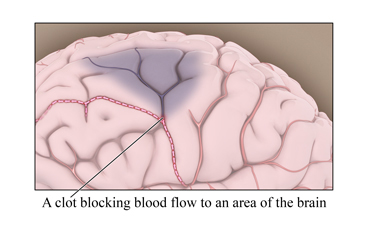
What is thrombolytic treatment?
Thrombolytics are medicines that dissolve blood clots. Most strokes are caused by a blood clot. This kind of stroke is called an ischemic (say "iss-KEE-mick") stroke. For an ischemic stroke, this medicine can dissolve the clot quickly and help blood to flow in a normal way again. This can help limit damage to the brain.
The medicine is given through a vein in your hand or arm. It travels through the bloodstream to the clot.
Doctors try to give the medicine within 4½ hours after stroke symptoms start.
An example of this medicine is called TPA (tissue plasminogen activator).
How does thrombolytic treatment help during a stroke?
When a blood clot moves to a blood vessel in the brain, it blocks blood flow to that area and causes a stroke. Without blood and the oxygen it carries, that part of the brain starts to die. If blood supply isn't restored, permanent damage usually occurs. The body parts controlled by those damaged cells can't work, or function, as they should. This loss of function may be mild or severe. It may be short-term or lifelong.
Thrombolytic treatment can improve recovery from a stroke. Doctors try to give it as soon as possible after the stroke happens. It can limit brain damage from a stroke by dissolving the blood clot. Without medicine to dissolve it, a blood clot in your brain is more likely to cause serious brain damage.
In general, the less damage there is to the brain tissue, the less disability a stroke causes. And with less damage to brain tissue, you are more likely to recover from the stroke.
No treatment can guarantee a full recovery from a stroke. But this medicine does improve your chances of having less or no disability after a stroke.
What are the risks of thrombolytic treatment?
The main risk of thrombolytic treatment is that it can cause serious bleeding in the body. If bleeding happens in the brain, it can cause worse stroke symptoms or even death.
Doctors are very careful about using this medicine. For example, a brain scan is done before treatment to make sure you have no signs of bleeding. (Thrombolytic treatment would make any bleeding worse.) And after treatment, you are closely watched for some time to make sure you have no internal bleeding.
Is there another treatment choice?
When your doctor tells you that thrombolytic treatment is a choice for you, it's because he or she believes that it offers you the best chance of recovery from stroke. But because this medicine also has risks, it is up to you to choose it or not.
Based on your condition, your doctor will explain what other choices you have for treatment. They may include other medicines that stop the clot from getting bigger.
With or without thrombolytic treatment, you will have care to help you get better. And you'll have medicine to prevent blood clots and control symptoms.
Having a stroke can make it hard to make quick and complex decisions. Feeling afraid or anxious can make it even harder to think clearly. Your hospital staff understands this. They will explain your choices and answer your questions. And they will help you decide about your treatment.
Current as of: October 2, 2025
Author: Ignite Healthwise, LLC Staff
Clinical Review Board
All Ignite Healthwise, LLC education is reviewed by a team that includes physicians, nurses, advanced practitioners, registered dieticians, and other healthcare professionals.

